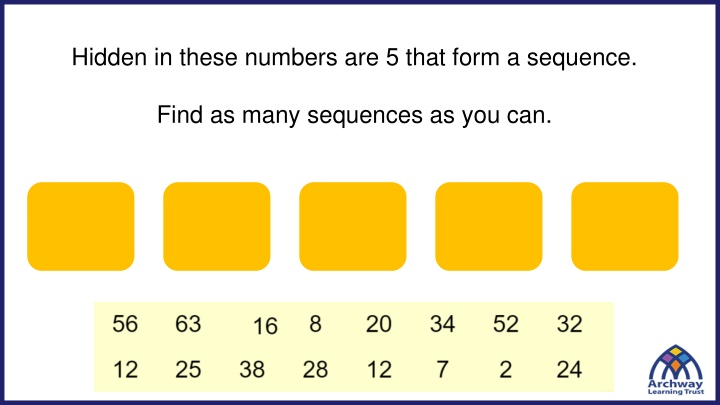
Exploring Linear Sequences: First Terms and Next Steps
Dive into the world of linear sequences with this interactive guide. Discover examples of ascending and descending sequences, find the next terms in various sequences, and explore the patterns hidden within numbers. Test your knowledge with exercises to identify first terms and constant differences in linear sequences.
Download Presentation

Please find below an Image/Link to download the presentation.
The content on the website is provided AS IS for your information and personal use only. It may not be sold, licensed, or shared on other websites without obtaining consent from the author. If you encounter any issues during the download, it is possible that the publisher has removed the file from their server.
You are allowed to download the files provided on this website for personal or commercial use, subject to the condition that they are used lawfully. All files are the property of their respective owners.
The content on the website is provided AS IS for your information and personal use only. It may not be sold, licensed, or shared on other websites without obtaining consent from the author.
E N D
Presentation Transcript
Hidden in these numbers are 5 that form a sequence. Find as many sequences as you can.
This is an example of an ascending linear sequence 8 12 16 20 24 +4 +4 +4 +4
The first term is 8 The constant difference is 4 8 12 16 20 24 +4 +4 +4 +4
This is an example of an descending linear sequence 32 28 24 20 16 4 4 4 4
What is the first term? What is the second term? What is the constant difference? 32 28 24 20 16 4 4 4 4
Hidden in these numbers are 5 that form an ascending linear sequence. Can you find it? Any others?
What are the next three terms? 19 25 31 43 37 +6 +6 +6 +6
What are the next three terms? 19 25 31 43 37 +6 +6 +6 +6 +6 +6 +6
Hidden in these numbers are 5 that form a descendinglinear sequence. Can you find it? Any others?
What are the next three terms? 6.4 6.1 5.8 5.2 5.5 0.3 0.3 0.3 0.3
What are the next three terms? 6.4 6.1 5.8 5.2 5.5 0.3 0.3 0.3 0.3 0.3 0.3 0.3
In your book Title: Linear Sequences Q2. Write the first five terms of each linear sequence Q1. Find the next three terms in each linear sequence a) 15, 29, 43 b) 60, 74, 88 c) 800, 1100, 1400 d) 90, 85, 80 e) 0.9, 1.2, 1.5 f) 7.42, 6.81, 6.2 g) 90, 88 h) 100, 101.5 i) 99 a) The first term is 15, the constant difference is 14 b) The first term is 15, the constant difference -2 c) The first term is 8000, the constant difference is 999 d) The first term is 4.7, the constant difference is 2.5 e) The first term is 4.7, the constant difference is -0.2
Mark and correct your work Q2. Write the first five terms of each linear sequence Q1. Find the next three terms in each linear sequence a) 15, 29, 43, 57, 71, 85 b) 60, 74, 88, 102, 116, 130 c) 800, 1100, 1400, 1700, 2000, 2300 d) 90, 85, 80, 75, 70, 65 e) 0.9, 1.2, 1.5, 1.8, 2.1, 2.4 f) 7.42, 6.81, 6.2, 5.59, 4.98, 4.37 g) 90, 88, 86, 84, 82 h) 100, 101.5, 103, 104.5, 1.6 i) 99 (an infinite number of options) a) 15, 29, 43, 57, 71 b) 15, 13, 11, 9, 7 c) 8000, 7001, 6002, 5003, 4004 d) 4.7, 7.2, 9.7, 12.2, 14.7 e) 4.7, 4.5, 4.3, 4.1, 3.9
Each line of Hexagons forms a linear sequence. Fill in the missing terms
